Hurricane Ian: A Profoundly Polluting Event
by Brian Czech
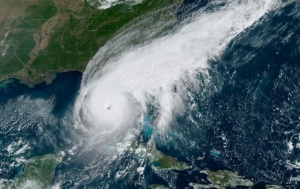
Hurricane Ian: a profoundly polluting event. (Public Domain)
If you’re a steady stater, I know what you’re thinking about Hurricane Ian. For starters, of course, you’re deeply concerned about any family or friends you may have in Florida, along with folks in general along Ian’s path. But you’re also wondering, “What about the pollution?”
The marine pollution that accompanies coastal flooding, most notably from violent hurricanes, is probably ignored by the majority of folks, or thought of only in passing. Throwing up our hands and assuming it a lost cause to worry about such pollution is somewhat understandable, because once a hurricane is en route, very little can be done. Ian is at this moment ushering a panoply of pollutants into the Gulf of Mexico and the Atlantic Ocean per se.
But Ian is just one hurricane, and hurricanes are just one type of flooding event. Now is the time for the wake-up calls to penetrate our local and regional planning authorities, as well as state and federal policy makers who have a say in the rate of growth along our coasts. The costs of inaction include severe marine pollution, loss of coastal freshwater supplies, fiscally debilitating cleanup costs, and the imperilment of numerous species. Furthermore, for all practical purposes many of these costs will be permanent. In other words, we won’t be able to “pay” them out of existence.
Climate Change and Coastal Flooding
Last night on live TV, Don Lemon of CNN was shut down by Jamie Rhome, the acting director of the National Hurricane Center. He’d simply inquired about the linkage between climate change and Hurricane Ian. Rhome replied, “Well we can come back and talk about climate change at a later time; I want to focus on the here and now.”
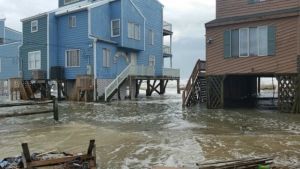
Coastal flooding: slowly via sea-level rise and quickly via hurricane. (CC BY 2.0, NCDOTcommunications)
Rhome’s answer was what we would expect from a politician—for example a coastal mayor or a Gulf state governor—but not from a scientist. Her desire to focus on the “here and now” was understandable with Ian barreling along, but she could have just as easily replied, “Yes, climate change increases the likelihood and intensity of hurricanes. That said; I’d like to focus on the here and now.” A straight answer would have been consistent with her own agency’s findings and the consensus among climate scientists. It also would have contributed, as we’d expect of a tax-paid civil servant, to the knowledge base required of American citizens to respond more wisely to climate change, coastal flooding, and pollution.
In addition to exacerbating the threat of hurricanes, global heating causes sea-level rise. Sea-level rise is essentially a relentless, slow-motion flood, gradually submerging low-lying areas, destroying wildlife habitats, and inundating the freshwater supplies of coastal towns and cities.
In a sense, saltwater is pollutant #1 along our coasts, some of which are far more vulnerable than others. In the USA, the Gulf states are most at risk due to coastal subsidence, which is especially pronounced in Louisiana. That said, all coastal states are vulnerable to sea-level rise except in far northern areas where post-glacial, isostatic rebound is pronounced (most notably in southeast Alaska).
Salts are a major pollution problem over large swaths of the USA. Saltwater is laden with numerous salts including sodium choride, calcium carbonate, potassium chloride, and gypsum. The deposition and buildup of these salts in coastal communities and habitats is like a salt problem on steroids, and that’s just the start of the pollution problem.
Coastal Development Brings Coastal Pollutants
As the National Oceanic and Atmospheric Administration (NOAA) reminds us, “Most ocean pollution begins on land.” That’s because land is where we live and (except in rare cases) where we work. Coastal land, especially, is where a lot of this living and working is concentrated.
Approximately 95 million Americans, nearly 30% of the population, live in coastal regions, most of which are vulnerable to hurricanes. All else equal, then, we could assume roughly a third of the economic activity—the general source of pollution—occurs in these regions.
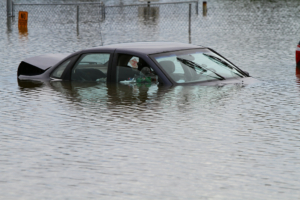
What’s along the coast is what gets flooded. (CC BY 2.0 , Chris Waits)
Of course, not all else is equal. For example, the bulk of big agriculture happens in the Midwest and central California, such that the fertilizer pollution problem is pronounced in freshwater bodies. Notwithstanding the fact that some of the fertilizer load originating upstream makes its way downstream to oceans, we are concerned here primarily with pollutants transported directly into the ocean from coastal ecosystems and communities as a result of coastal storms and flooding.
Consider this abbreviated list of economic activities, infrastructure, facilities, and artifacts found in coastal counties:
- Coal-burning plants
- Nuclear plants
- Power plants in general
- Oil refineries
- Cash cropping
- Hog farming
- Aquaculture
- Manufacturing
- Services including transportation (such as gas stations), construction, warehousing, health care, recreation, etc.
- Landfills
- Cars, trucks, houses, and septic tanks.
Basically, “It’s the economy,” planners. If you’re planning for even more of it—you pro-growth coastal planners and politicians—you’re a big part of the problem, especially in the context of climate change.
Hurricane Ian, Itself and as Harbinger
Late last night on Fox News, not long after Don Lemon was shut down on CNN, Florida Governor Ron de Santis called Hurricane Ian “one of the biggest flood events we’ve ever had.” That was correct, and would have been just as correct if he’d called it “one of the biggest pollution events we’ve ever had.” And that puts it high on the list of American pollution events, too.
With a population of nearly 22 million and a GDP of over a trillion dollars, Florida has the fourth-largest economy among U.S. states, less bloated than only California, Texas, and New York. It also has the second-longest shoreline; second only to Alaska. Over half of Florida’s counties are coastal per se (with Atlantic seaboard or Gulf of Mexico shoreline).
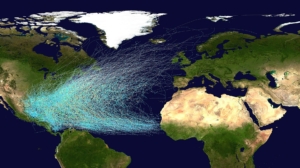
Hurricane Alley leads to Florida. (Public Domain)
With all that economic activity in conjunction with its distinctive economic geography, it doesn’t take a deep dive into a polluted estuary to recognize that the economic activities listed in the preceding section are each prominent in Florida. That helps to explain why Florida has a huge issue with its freshwater supplies, a disastrous plastics pollution problem, and the third most endangered species among U.S. states.
And finally, Florida is right in the bullseye of Hurricane Alley. BP itself couldn’t devise a more perfect set-up for marine pollution.
That’s why environmental scientists are kept up at night and environmental protection groups have been working overtime to warn whoever will listen about what’s at stake. Whether it’s the billion tons of phosphate fertilizer waste, the nine million gallons of leachate at the Lee/Hendry Solid Waste Facility, or the radioactive materials at the Turkey Point Nuclear Generating Station, there’s hardly a unit of matter in the coastal counties of Florida that won’t be hit by the intensifying hurricanes of the globally heated 21st century.
Yet DeSantis and other Florida politicians boast about the rate of Florida’s GDP growth!
Connecting the Dots for Coastal Planning
Let’s see if we can connect some dots for coastal planners, policy makers, and voters. First we have the process of economic growth—increasing production and consumption of goods and services—entailing a growing population and per capita consumption. We still have a primarily fossil-fueled economy (with some coastal nuclear power thrown in), so the growing economy fills the atmosphere with greenhouse gases.
The proliferation of greenhouse gases causes global heating, which in turn causes sea-level rise and the intensification of hurricanes.
Sea-level rise and hurricanes inundate our economic facilities and waste disposal sites. Hurricanes, especially, move materials, components, products, and wastes from inland sites to estuarine and marine environments.
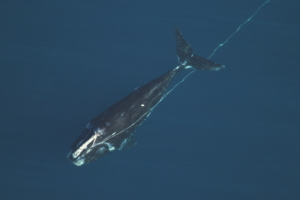
Entangled whale: symbol of a bloated economy. (CC BY-NC-ND 2.0, FWC Fish and Wildlife Research Institute)
Offshore, the vestiges, artifacts, and relics of economic activity degrade our oceanic ecosystems. They alter ocean chemistry, leading to the bleaching of coral reefs (exacerbated by ocean heating) and the demise of fisheries. Animals ingest many of the pollutants, especially plastics ranging from micro to macro. In a somewhat inverse phenomenon, pollutants encompass whole animals; including some of the largest and most precious among them.
As mainstream environmental organizations are accustomed to pointing out, all this environmental impact is a threat to the economy. The Ocean Conservancy, for example, has “a vision for Florida’s ocean and coasts.” They obviously strive for ocean conservation, and find it compelling (and hope it will be for all concerned) to tell us that “Almost half a million Floridians work in the ocean economy, which includes jobs in tourism and recreation, marine transportation, marine construction, ship and boat building and living resources (including fishing). Florida employs more people in marine construction than any other state and ranks 2nd nationally in total ocean employment. The ocean economy contributes $30 billion annually to Florida’s gross domestic product.”
Unfortunately, the conservancy fails to show us the other side of the coin; namely, that it’s all that economic growth that threatens our oceans to begin with!
With environmental messaging like that, the likes of DeSantis, Jeb Bush, Rick Kriseman, Marshall Goodman, and the rest of the Florida politicians hellbent on economic growth will never arrive at the solution of degrowth toward a steady state economy. Instead, they’ll be pushing for GDP growth and causing more global heating, sea-level rise, hurricanes, pollution, environmental impact, and—ironically enough—the collapsing of the economy.
 Brian Czech is CASSE’s Executive Director. He led sea-level rise planning efforts for the U.S. Fish and Wildlife Service earlier in his career.
Brian Czech is CASSE’s Executive Director. He led sea-level rise planning efforts for the U.S. Fish and Wildlife Service earlier in his career.

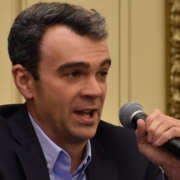





It’s almost chickens coming home to roost, except that the victims are not the original perpetrators. My only minor quibble about this superb article is that it’s not only the Florida politicans “hellbent on economic growth”. Has any politician, coastal or otherwise, ever mentioned “degrowth toward a steady state economy”?
I believe the answer to your question, Mark, is “Not any prominent, elected ones, especially in the USA.” On the other hand, there are numerous examples of lower-level political figures — elected or appointed — who have dabbled in steady-state economics (for example, Doug LaFollette, the Wisconsin Secretary of State).
I’d be shocked if there haven’t been some avowed degrowthers in Europe who likewise have been active in electoral politics.
For purposes of keeping track, we maintain the CASSE signatory list, including our featured or “notable” signatories: https://steadystate.org/act/sign-the-position/endorsements-and-signatures/view-notable-signatures/ . We see there, for example, that Caroline Lucas, a long-time steady stater, was a member of the European Parliament.
One thing is clear: We have a long way to go! But it’s also pretty clear we are making some headway. It’s part of our job at CASSE to conduce such steady-state and degrowth politics.
My comment should not be interpreted as pessimism. You can’t go wrong with signatories like Vandana Shiva and Wendell Berry. Here in France, every large city voted for an environmentalist mayor, mostly green party. Though those mayors do not use the D-G word, some of their policies do, and many of their voters as well. I posted an intro to the Steady State website on my facebook, knowing that pictures and personal stories get much more response than something that requires reading. That just shows that a degrowth path to a steady state will also cut into the speed addiction and reduce the time poverty that overwhelms our culture these days.
Dear Brian – a great piece, thank you.
Could I also ask you to add your wake-up call not only to ‘local and regional planning authorities’, but also to development companies themselves? No doubt, the authorities you mention are being/have been badgered day by day by those companies to ‘approve, approve, approve!’ quickly, and being blamed for increasing the costs by their delays in doing so.
The company staff must be led to understand that they themselves have a duty in ethics to assess the values (short and loner term) they’re promoting with each application for development. Mention to them the B Corp/B Lab movement which calls on businesses to apply values to their proposals – assessment values for environmental, community/social consequences of those proposals. Putting authorities, working often in very difficult situations of lack of hard information about possible future events and while also under serious economic pressure, can be very harrowing, if not unfair.
Interesting perspective, Len. It’s been my opinion that private sector sustainability initiatives would be like a cart drawn by the horse of public policy. And you know what they say: Put the horse before the cart. But your point is well taken, and maybe a better metaphor is chickens and eggs.
We could use an article on B Lab and how effective it might be for degrowth toward a steady state economy. Guidelines are here: https://steadystate.org/learn/steady-state-herald-submission-guidelines/ .
Never thought about Hurricane Ian from this point of view. I was only thinking about the stormwater management. But this also is very interesting. Thanks for sharing!